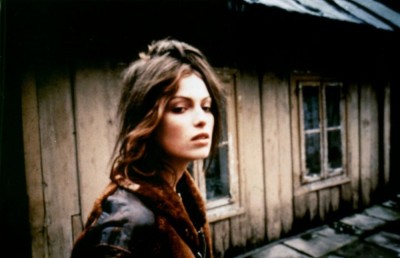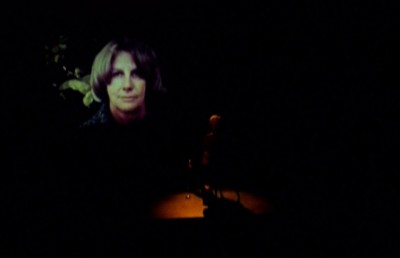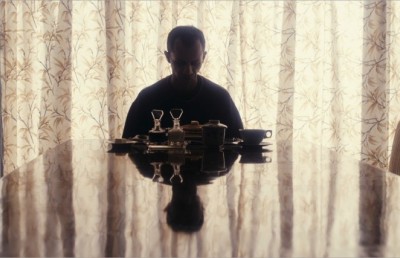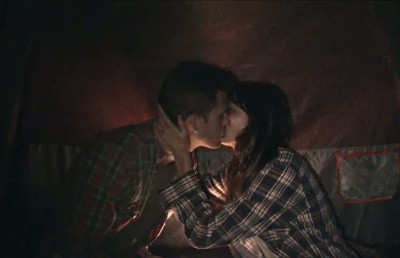A Lesson of the Evil at Fantasia 2013
Takashi Miike takes us back to school
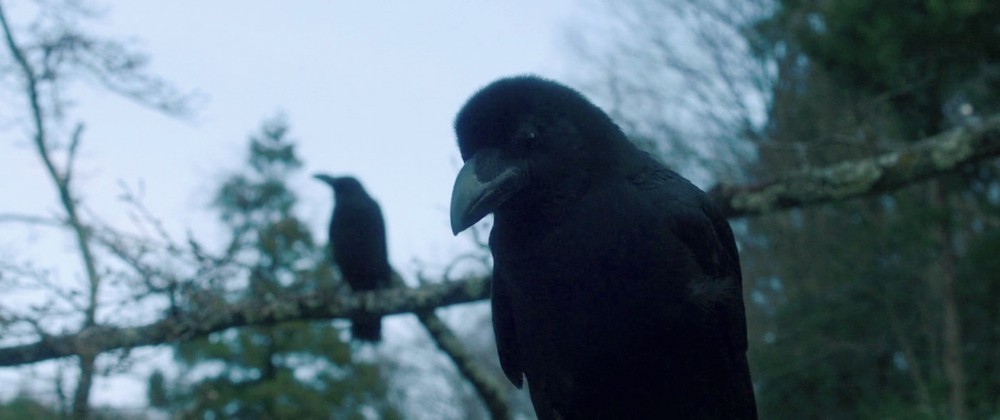
Homecomings
For the first time in 10 years Fantasia has returned to the legendary Imperial Theatre, site of the festival’s birth and home to its first six years. When relations with the Imperial’s management went sour in 2002, Fantasia was cancelled for that year. After defibrillation we all picked ourselves up off of the floor and brooded over what felt like the end of an era. Then the news came that the festival would return for 2003 at a new venue: Concordia University. Prepared for the worst, I was pleasantly surprised at how well it worked (see my 2003 coverage of the transition here), and we haven’t looked back since. Until now, when delayed renovations to the Hall Theatre forced a new temporary venue for 2013. The Imperial was once again available, and it was a homecoming to be sure. But the return also underlined the fact that you can never really go home once you’ve been gone for a decade. The Imperial is fabulous, but something of the vibe of those early Fantasia years was missing, as though the festival’s animating spirits have ceased their haunt of the Imperial’s baroque ornamentation and floated down de Maisonneuve boulevard to take up residence between the slats of the Hall Theatre’s wood-paneled wings. Perhaps these spirits are made manifest through a venue’s gradual seasoning over years of exposure to the world-famous enthusiasm of Fantasia’s audiences; hopefully they aren’t living in the Hall Theatre’s battered old seat cushions, to be replaced at long last in time for the festival’s return to Concordia in 2014.
Despite the missing je ne sais quois, the festival’s setting this year proved the ideal context in which to contemplate Takashi Miike’s Lesson of the Evil, the first Miike film to really excite me since his millennial heyday. The film has been touted as a welcome return to the prolific director’s exploitation roots. Indeed, the film delivers the buckets of blood that Ichi-heads have been craving since Miike’s departure from the staples of his early gangster fare and subsequent horror crossovers. Another homecoming, of sorts, after Miike’s decade on the lam since bending his beloved gangster genre so far out of shape with Gozu that there was nowhere left to run but away. Far, far away. As Tom Mes charts in his excellent collection of essays on the director’s output over the last ten years (reviewed here), the diversity of Miike’s more recent projects has been dictated, in large part, by the ebbs and flows of industry: Japanese producers have moved away from the video market that made Miike’s early work possible and into the area of highly commercial theatrical cinema. That Miike has been able to keep working through these shifts is a major feat. His adaptability in this regard may prove to be his most characteristic trait in the end. But those of us whose enthusiasm for Miike’s work has waned along with these changes can’t help but hope for glimpses of the filmmaker we once knew. Though it’s pure happenstance that Miike’s shift away from his turn of the century staples has paralleled Fantasia’s change in venue, this makes it all the more fitting that Lesson of the Evil’s return to form just happened to coincide with Fantasia’s return home to the Imperial.
But Lesson of the Evil offers much more than blood spatter. I took my seat in the theatre expecting disappointment, a feeling reinforced a few days earlier when the festival opened with Miike’s dull police procedural Shield of Straw. But it didn’t take long for my mood to change once the lights went down and Lesson of the Evil settled into the slow burn of its first hour. Traces of Audition’s emotional tension and Gozu’s oddball supernatural flourishes were tantalizing, but what got me most excited was the film’s most thematically integrated use of bird imagery since Dead or Alive 2. Ten years ago I wrote at length about the significance of bird imagery in Miike’s work to date, and have long planned a follow-up – only to be continually thwarted by the lack of significant development of the motif in Miike’s later work (the biggest letdown being Crows Zero, which had zero to do with crows). When Miike engages with these creatures substantially, they peak his cinematic imagination in ways that are absent from a lot of his work – particularly of late. I think Miike is at his best when he is able to lift the genre fare with which he is charged out of its bounded constraints and into another plane. For a time, the motif of birds allowed him to do just that. They frequently offer pause to reflect upon the action of the film from a different vantage point, occasionally lifting that action to another realm altogether. I once waxed philosophical about the role of birds in his films as agents of “de-territorializing” flight (after Deleuze and Guattari’s A Thousand Plateaus), a good enough analogy for the paths that birds have traced out of the boxes within which Miike has spent his career working. But the birds haven’t flown as they once did, their wings clipped as Miike himself took flight into the new domains of Japan’s shifting film industry. In this regard Lesson of the Evil marks something of a “re-territorialization” while exploring the roots of this territory more deeply than ever before. Simply put, Lesson of the Evil is the best Miike film since Big Bang Love promised an avant-garde turn that never quite materialized. Or perhaps it would be better to say that Lesson of the Evil will get you halfway there.
Two Films for the Price of One
Lesson of the Evil is two-faced from surface to core and all points in between. It is divided neatly in half. The first hour delivers an understated thriller of skillfully measured pace that sets up Hasumi as a well-loved and charismatic high-school teacher who aids the administration regulate affairs like school bullying and in-class cheating while advocating for troubled students – even if he does get a little too involved with one or two. The second half reveals Hasumi as an apparent psychopath who has bugged the school at strategic points to keep tabs on what is being said about him and gather dirt on his co-workers, and resorts to killing anyone who gets too close to his suspicious past marked by a trail of death leading all the way back to the murder of his parents. In the end, threat of exposure compels Hasumi to kill off the entire graduating class with whom he has been professionally associated, which plays out in a 45 minute shooting spree during the students’ overnight preparations for their graduation party.
The precise narrative division of the film reflects Hasumi’s divided character and plays out through various thematic and aesthetic strategies – all of which revolve around a pair of ravens that stalk the teacher mysteriously. The birds provide our first clues in the opening hour that there is something odd at work in Hasumi’s world, and they connect Hasumi’s actions to the larger theme of identity construction in the age of ubiquitous surveillance technologies. Hasumi wants to control his image in the minds of others, and employs surveillance tactics to help him do so. But he is also being surveyed by the birds who, as the film progresses, are increasingly embodied by the students that threaten to expose Hasumi’s identity to the world.
Hasumi’s concealed identity is set up right from the opening sequence. The film begins in darkness with the sound of an old scratchy rendition of “Die Moritat von Mackie Messer”, the original German version of “Mack the Knife”, detailing the adventures of violent thief Mackie Messer that bookend Brecht and Weill’s The Threepenny Opera. A conversation begins as a couple discusses the probability that their 14 year-old son is a serial killer. Their faces are shot in close up as they speak in hushed, anxious tones, their voices given equal weight on the soundtrack to the music. The conversation is intercut with shots from another part of the house, revealing a record player as source of the music while providing fragmentary glimpses of a young man getting dressed, picking up a knife, and walking up the stairs to approach his parents’ bedroom. These shots are carefully designed not to reveal the man’s face, contrasting with the emphasis on the visages of his next victims. The parents hear the squeak of the door to their room opening and the mother looks over, breathless with fear. And here the film cuts away, delaying any depiction of their fate until the film’s second half.
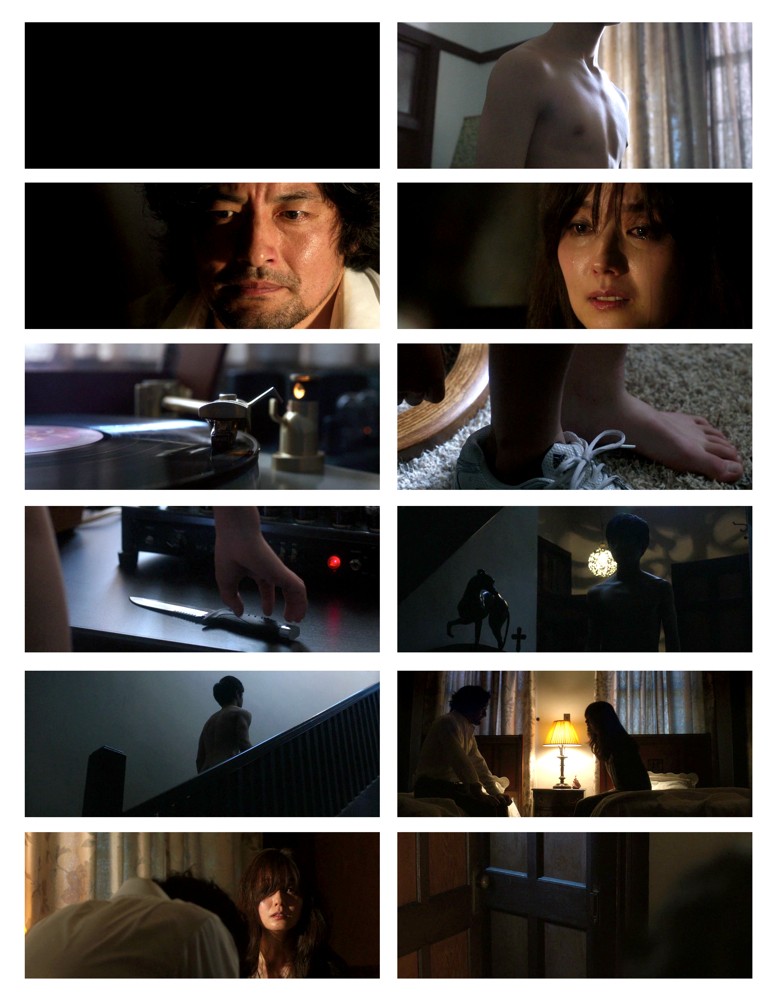
The film does not play as a mystery; there is little doubt that the young man in the opening sequence is meant to be Hasumi. Rather, the film uses the long-standing horror device of framing and lighting the killer to hide his identity to set up narrative and aesthetic strategies of fragmentation that enact the film’s broader themes of identity and surveillance. Throughout the film’s first half, Miike regularly cuts around depictions of violence in a structural evocation of Hasumi’s own concealed identity: like Hasumi, the film doesn’t make its violent side explicit until the second half. The film as a whole is thus premised on placing tension and release in stark relief; the first half is all tension, the second half is all release. But it is the space between the tension and its release that interests Miike the most, and this space is explored by way of the ravens that thread the film’s two halves together.
Surveying a Habitat
Instead of showing us the murder of Hasumi’s parents right from the start, the film cuts away to a shot of telecommunications antennae framed against a twilight sky as two ravens fly by.
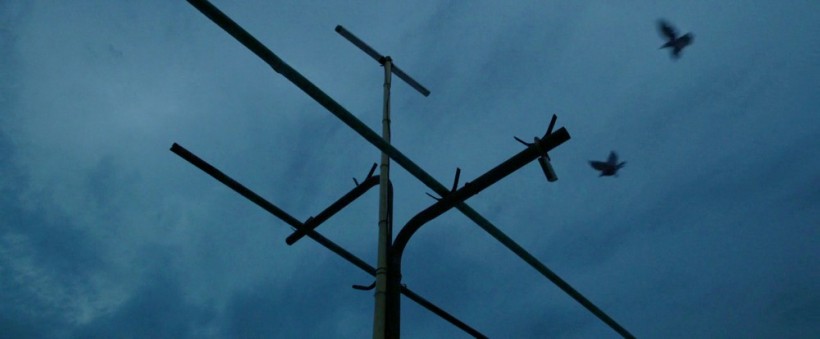
The shape of their bodies with wings extended in flight is mirrored by several bits of upturned metal on the structure, linking this technology with these birds and their ability to move through the air, threading disparate spaces together. And the film goes on to position these two ravens as figures from Norse mythology named Huginn (thought) and Muninn (memory), messengers to Odin, King of the Gods. Charged with keeping tabs on Hasumi’s activities, the birds also provide motivation for an approach to shot composition and camera movement that explores the aesthetics of surveillance and paranoia in the context of Hasumi’s desire to keep his past hidden.
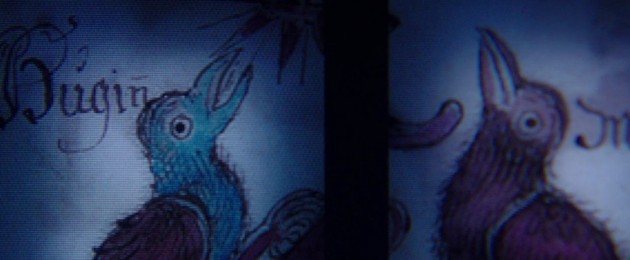
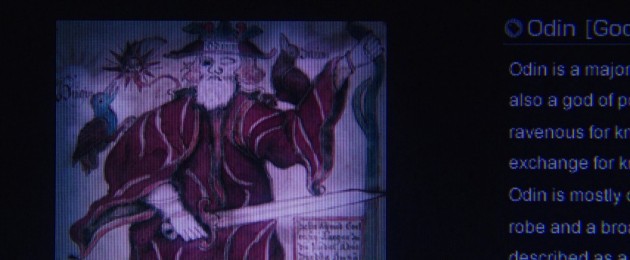
The birds are stalking Hasumi, and the film sets that fact up through formal devices that carry over the film’s other explorations of surveillance culture at the high school. The first example of this comes as Hasumi returns home at the end of a jog through the scenic hills outside of town to find the raven pair looking down on him from their perch. Across two shots the camera frames Hasumi arriving home while booming upwards to create a swooping gesture that recalls a bird in flight, finally making that connection directly with a cut to a shot of the birds landing in a tree above his house.
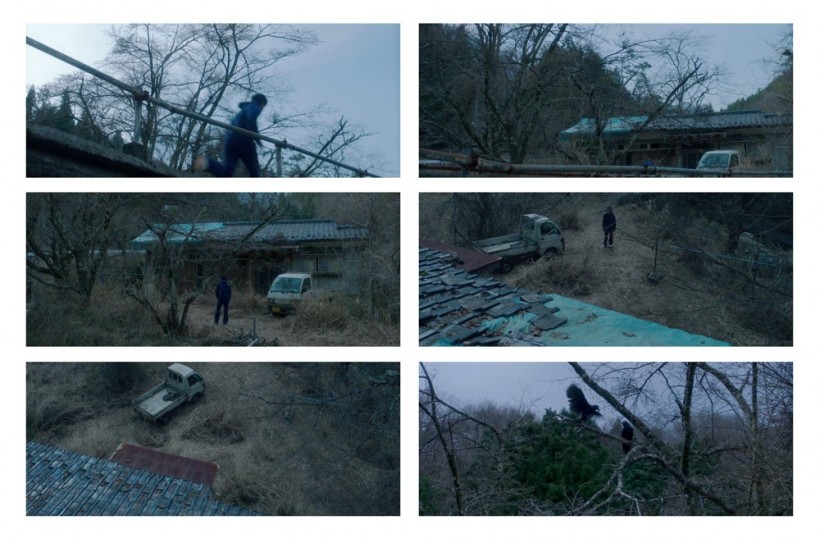
This sequence charges all subsequent uses of high angle framing and booming shots with the notion of surveillance tied to the birds but present also in their absence. One particularly poignant example comes when Hasumi is on the rooftop with smitten student Miya. She hugs her teacher awkwardly, and he transitions the initiative into a long involved kiss. The camera tracks around them as the kiss progresses, revealing an upper level to the roof behind them. The film then cuts to a high angle shot from this perspective, evoking a feeling of being watched. A noise breaks the couple’s embrace as they look upwards, and after Miya runs back into the school, Hasumi discovers another student watching them from above.
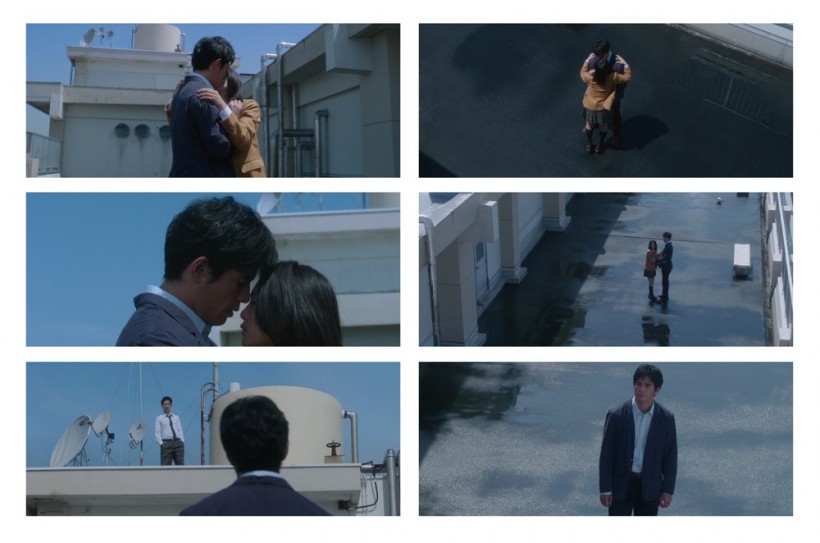
This scene brings the vague menace of the ravens into the tangible reality of the school’s student population exposing Hasumi’s illict activities by way of tying its emphasis on high angle framing to the act of surveying. The kids are angry because Hasumi has been successfully jamming their cell phones during exams, preventing them from cheating. It’s a battle for control over the airwaves, and Hasumi doesn’t like being watched.
Midway through the first half the film reveals Hasumi’s dislike of his black feathered stalkers. He rigs a metal perch outside his window with electrical wire, the first hint of his violent side, confirmed by his whistling to the tune of the same version of “Mack the Knife” heard in the opening sequence. When Huginn lands on the trap, Hasumi opens the circuit, dropping the bird to the ground head first. Hasumi retrieves the corpse and then disposes of it in his back yard bin under the watchful eye of its partner Muninn – whom Hasumi later spares with the warning that he has the power to kill her at any time.
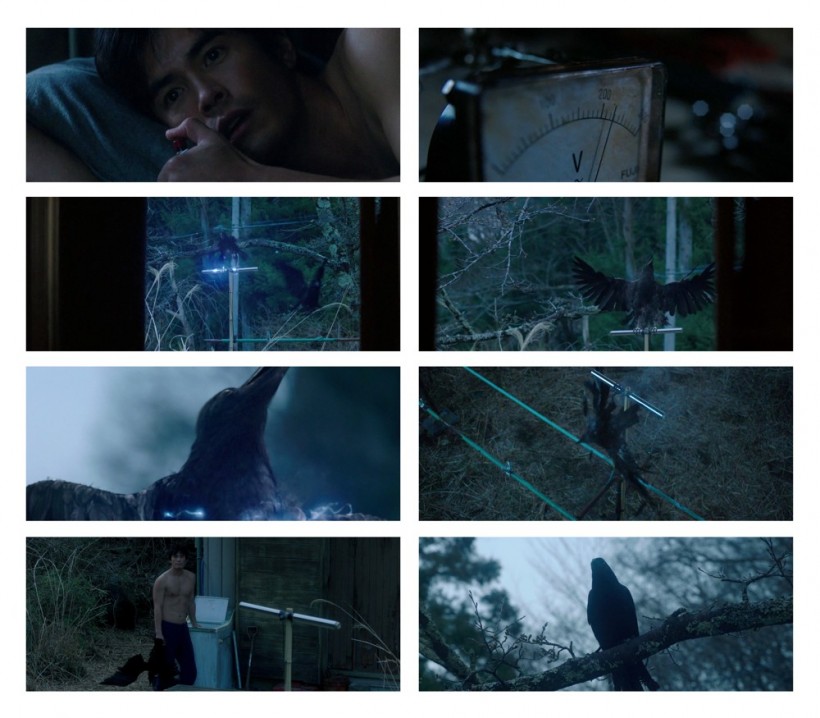
Sparing Muninn is a gesture calculated to demonstrate control over those who would see Hasumi deposed. Rather than ensure complete autonomy from surveying eyes, Hasumi enjoys the power that comes with keeping those eyes under control. At least until threats against this power become unmanageable and he feels compelled to do away with the whole lot.
Graduation Day
Killing Huginn foreshadows the actions Hasumi will take against his students and fellow faculty in the film’s second half. These actions begin at the one-hour mark with the murder of Mr. Tsurii, Radio Club staff advisor who has been investigating the trail of apparent suicides left in the wake of Hasumi’s previous jobs. Of course, Hasumi makes Tsurii’s death look like a suicide, hanging him from the hand-rail in an empty subway car on his commute home one evening. And the violence escalates from here.
After a flashback sequence that shows Hasumi in training with a more experienced serial killer in New York City, during which he is also schooled on the Brechtian origins of “Mack the Knife” and its subsequent jazz revivals, the film lands at the high school after hours where the entire graduating class has gathered to decorate their hallowed halls with fantastical themes for the big party to come. Here the tone of the film changes dramatically, abandoning the slow burning tension in the first half for a psychedelic foray into the bloody rampage of calculating psychopathy that plays out like a first person shooter game set at a circus arcade.
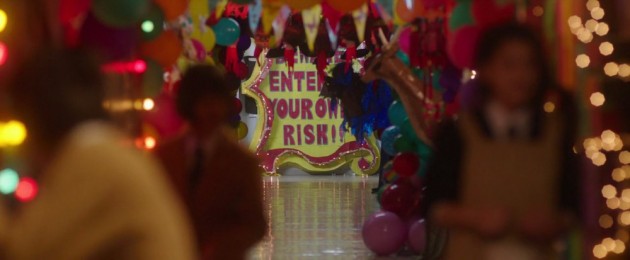
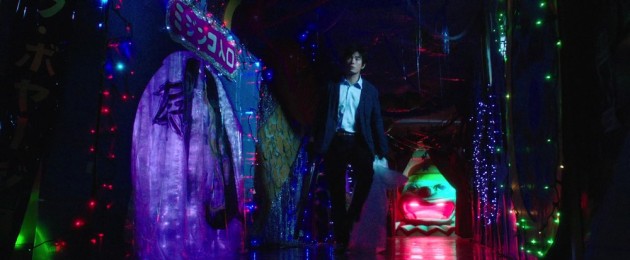
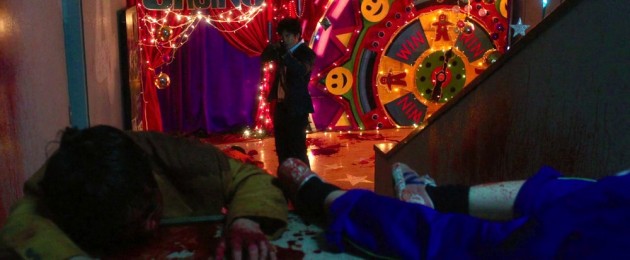
While most of the students still believe he is a good guy, Hasumi gets on the PA system to announce an intruder with a shotgun and instructs everyone to go to the roof. Hasumi is shown in the control room with a dozen monitors letting him see all the movements of the people as we learn that he has successfully jammed their cell phone reception. Hasumi thus uses this “game” as a chance to reassert his control over the school by commandeering its surveillance technology, at the same time milking his still hidden identity to trick his students into stepping into his trap.
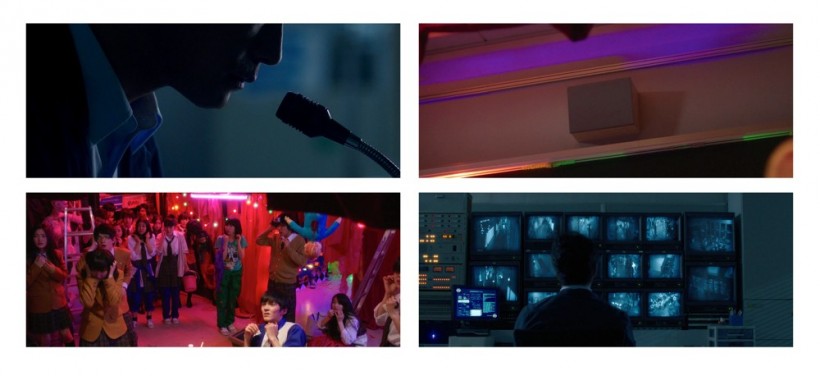
Hasumi tracks them into a stairwell where they’re easy pickings, and the horror on their faces is well registered as they realize that their teacher isn’t there to help them after all. And Hasumi delights in their collective recognition that he has successfully concealed his true nature from them until the precise moment of his own choosing.
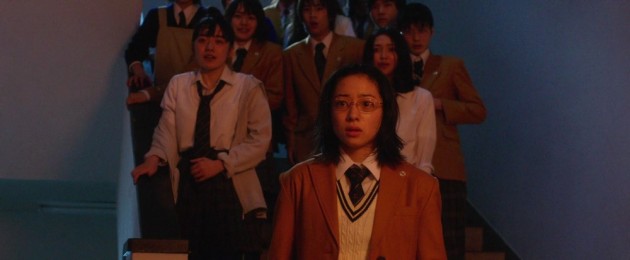
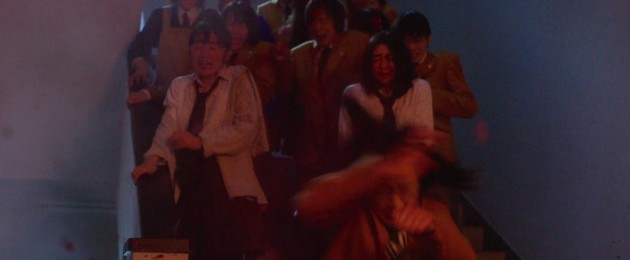
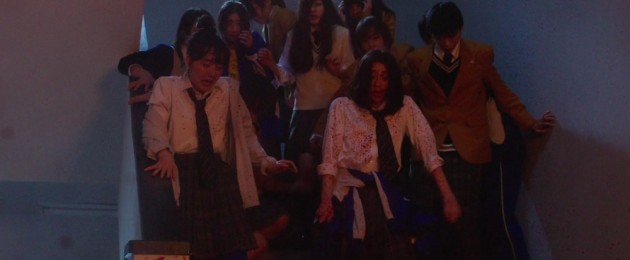
But in the end, it is surveillance technology that reveals him as the killer to the police. Though he ends the rampage by destroying the school’s monitoring station and framing one of the other teachers to make it look like a murder/suicide, two students manage to survive the spree and lead police to a cardiac resuscitation unit with a sound recording function that has captured tangible evidence of Hasumi’s guilt.
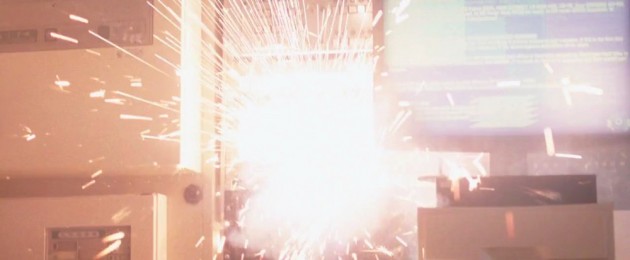
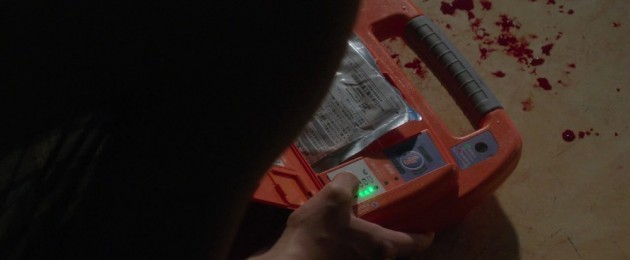
Hasumi’s fear of surveillance technology proved well founded in the end – unless this is exactly how he wanted the game to play out.
Feathers to Flesh
The ravens don’t appear in the film’s second half – at least not in their bird form. Instead, Miike folds the theme of otherworldly surveillance into the harsh reality of the high school killing spree. Hasumi’s overt motivation for the killings is to protect his concealed identity. Too many eyes and ears have fallen on his past, and he needs to cut the ties. In this way, the students and faculty of the high school become the human embodiments of the ravens and their charge. But in case this suggested transposition of the birds reads too much like overinterpretation, Miike draws on the visual language deployed around the raven surveillance in the first half to draw direct connections between the birds and their human counterparts in the second.
The most important example comes in a moment of parallelism that connects Huginn’s fate to that of Miya. Just before Hasumi starts the mass slaughter, he meets with Miya on the roof – site of their exposed kiss earlier on – where he clubs her upside the head and then tosses her over the railing. The scene recalls the electrocution of Huginn, from the silver tubing of the railing to the upside down fall to the ground, rendered here in ultra slow motion to set it apart from the rest of the killings.
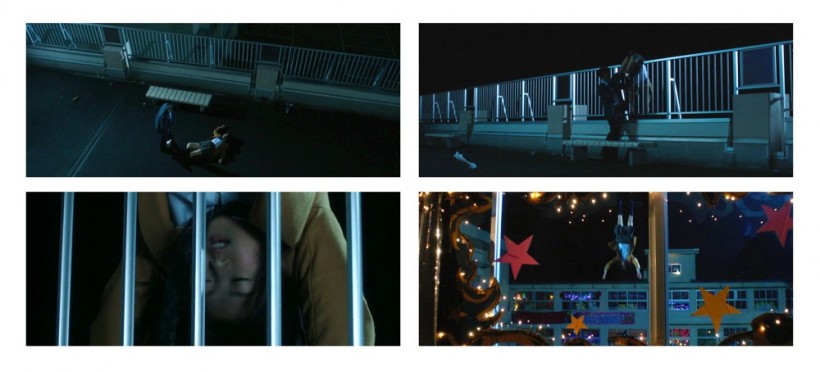
The connection between Huginn and Miya is then solidified in the film’s final moments. Finally caught after his rampage, Hasumi confronts the only two survivors about his reasons. “It was the will of God,” he says, claiming that the entire Year 4 class consisted of demons that needed to be exorcised. He then addresses the lone surviving girl as “Muninn”, and asks her to say “hello” to Odin for him. She responds with a shock of recognition. He’s not as crazy as her male counterpart exclaims; “He’s just starting the next game.” Did Hasumi spare the messenger intentionally, as he did before, in order to propagate this unnamed game?
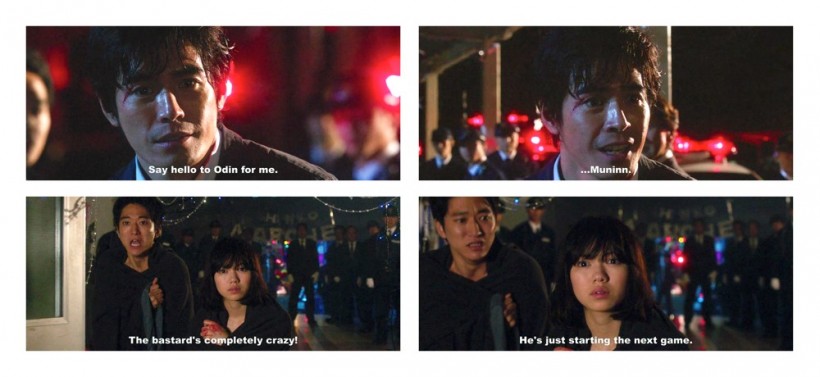
Her left eye clouds over, paralleling an earlier shot of Muninn with the same ocular affliction.
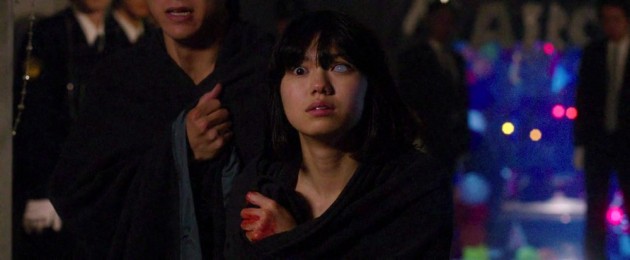

And with that, the film cuts to a high angle shot of Miya lying twisted on the ground where she landed, the camera swooping downwards to reveal a sudden heave of the chest and opening of the eye as she mutters Hasumi’s name before we cut to a title card reading “To Be Continued”.
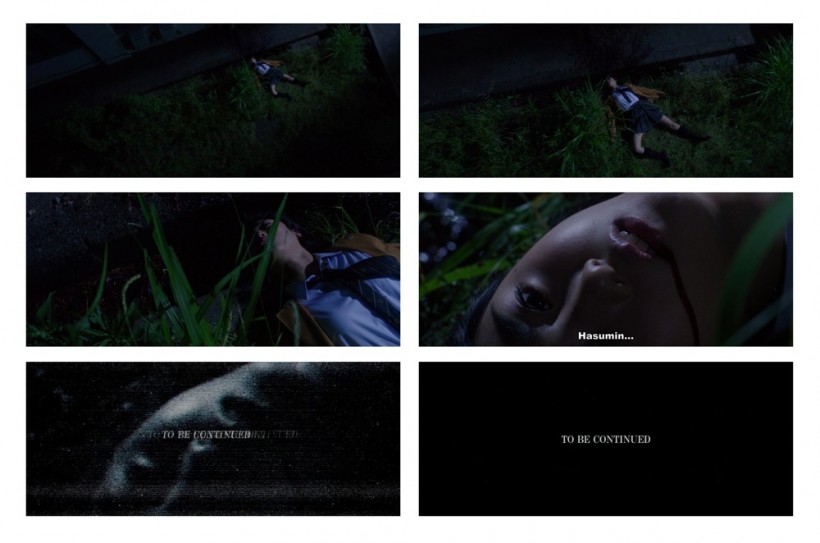
This ending acts as something of a deus ex machina descending from the heavens to provide an otherworldly explanation for Hasumi’s inconceivable actions. This is the most overtly supernatural moment of the film, returning to the theme of the raven, complete with a high angle booming camera, while opening the story outwards to an entirely new dimension – apparentlly to be taken up in a sequel. And yet this imagery could also be chalked up to Hasumi’s psychopathic paranoia, a mental state in which he projects the very real threats posed by his students and colleagues out onto the animal kingdom. Either way, the film’s conclusion hangs on Muninn’s evocation of “the game” as the framework through which the film must be interpreted.
Ups and Downs
So what is “the game”? It would seem that a new chapter promises the explanation. Taken as is, however, Lesson of the Evil feels incomplete. The main strength of the film lies in how it is divided in half for the express purpose of exploring avenues for threading the two parts together – and how this threading reflects the theme of identity formation in the age of ubiquitous surveillance technology. But this division comes at a cost. While I found the film’s opening hour to be pure magic, I will confess to some dissatisfaction with the second half. Taken at face value without expectations for a sequel, Lesson of the Evil‘s evocation of game play in the context of a high school shooting is not in the best of taste. Amidst the cardboard funhouses, casinos and haunted caves, the steady stream of brutal shootings resembles a carnival shooting gallery, bodies flying out of frame after being shot like metal ducks on a track. As a colleague of mine put it: “Who wants to watch a bunch of helpless teenagers get ruthlessly murdered for an hour?” Especially so when it involves a general abdication of the aesthetic qualities that made the first hour so engaging in favour of a relatively mindless spectacle. It didn’t help that the festival’s beloved stage-hand Daniel introduced the film by asking if any of us had seen Polytechnique, a local production detailing the horrors of the infamous “Montreal Massacre” of 1989 in which an armed misogynist shot 28 students of l’école Polytechnique before taking his own life. There wasn’t a peep from the room. Not because we hadn’t seen the film, but because there simply is no suitable reply. Although there would certainly be some value in drawing comparisons between how these two films (and many others) handle the theme of school shootings, the audience wasn’t in a position to start this discussion here. So what were we going to do, cheer? “Yeah, Polytechnique!!” Too close to home, even for a Fantasia audience well used to hooting and hollering during the vilest moments of cineviolence. No, the spectacle that closes Lesson of the Evil demands substantial justification beyond the catharsis that characterizes the pleasures of watching horror film violence for so many of its fans.
For me, the film’s second half is justified only by the promise of greater contextualization in the next chapter. Yet it is not at all clear that a new chapter will, in fact, be forthcoming – despite the film’s conclusion. Yusuke Kishi’s source novel of the same name appears to cover the same ground as the film. I don’t read Japanese, and my friends who do haven’t read the novel, so I’m at pains to offer anything but speculation on how the novel might inform a new chapter. The synopsis you can read here ends the story with Hasumi’s shooting spree, suggesting that the narrative range of the novel is covered by Miike’s film. However, as is the case with many novels in Japan, the book was released in two volumes simultaneously, differentiated in title only by the appendages “up” and “down” on each cover.
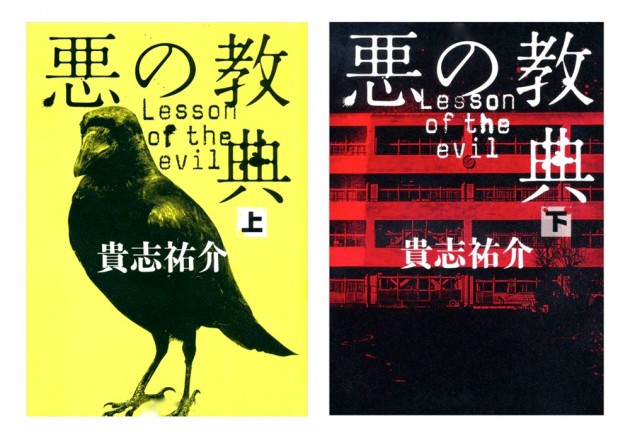
So there is room to speculate that book two – the “down” chapter – may, in fact, carry forward from where the story told in the film leaves off. On the other hand, it’s very likely that the film’s clear division into two halves reflects the structure of the novel across these two volumes, a strategy particularly well suited to this divided narrative about a divided man. Although it’s hard to imagine how the second volume of the novel could be sustained only by the shooting spree, it’s certainly possible – particularly if it contains many details that the film leaves out. Which is likely. If anyone out there has read the novel and can set the record straight, please drop me a line!
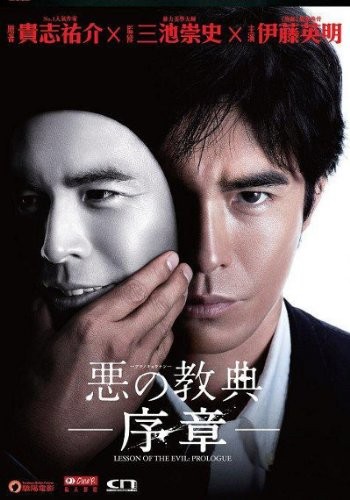
Another question about the breadth of the source novel lies in the mini-series apparently produced in conjunction with the film but without Miike’s touch. The series elaborates on the checkered past that Hasumi’s colleagues are so eager to uncover and that the film’s audience only glimpses in brief flashback sequences. Is this material gleaned from the original novel but not included in the film? Or has it been invented by the screenwriters? Either way, perhaps the next chapter will be framed as a follow-up mini-series rather than another theatrical film. If so, then I’m not expecting much satisfaction from the conclusion.
Although the mini-series features the same cast as the film, the stylistic qualities of the former are not nearly as interesting as the latter. For example, in the mini-series, the association between the ravens and surveillance technology is made explicit by following shots of the two birds with high angle point-of-view shots rendered with a black and white video aesthetic as though seeing the action through surveillance cameras (along with a goofily spooky soundtrack).
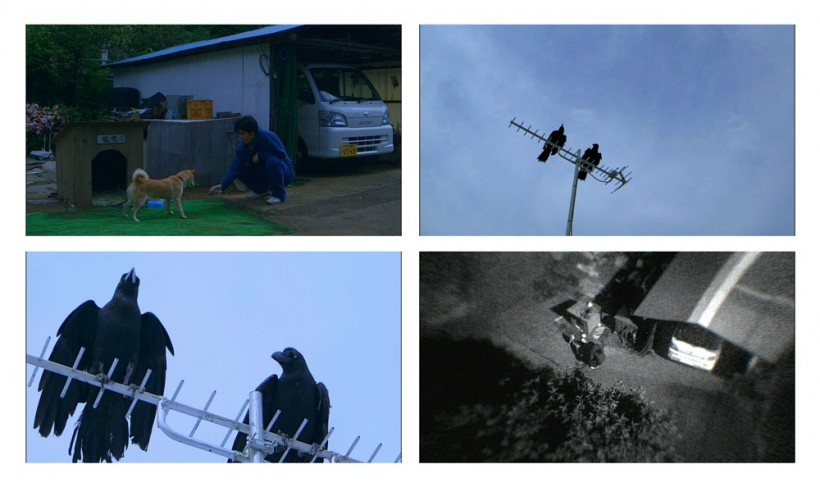
In the film, Miike didn’t need to be so explicit about connecting the birds with the technology that informs the narrative, preferring instead a looser approach that blurs the boundaries between objective and subjective positioning. This allows for a greater range of aesthetic possibility in the use of high angle framing, and greater mobility for the role of the birds in the story. In the mini-series, the “bird-cam” locks our reading of surveillance to this specific formal device, shutting down the game Miike plays with the intersubjectivity of the ravens and the high school girls through his use of framing and camera movement. This is but one example of Miike’s unusually strong authorial input on this project. As Tom Mes points out in his review on midnighteye.com, this film marks the first time Miike has penned his own screenplay, marking a heightened personal investment that makes the film exceptional amidst Miike’s oeuvre of the last decade. The mini-series does not bear Miike’s stamp, and without the attention given to the kinds of formal details I’ve described above, the story it tells isn’t really of much interest beyond standard genre fare.
Miike’s treatment of the film’s various divisions is brilliant: the narrative is split in two, tracking a character split in two, himself tracked by a pair of ravens that he splits in two, who then split themselves from their bird bodies to occupy the two female students. A kaleidoscopic effect emerges that would act as a wonderful set up to even further fragmentation in a new chapter. The promise of a highly experimental outing is grand, if Miike puts pen to paper either in adaptation of existing source material or to invent an expansion of its universe. Sadly, this will probably remain the stuff of dreams.
If the film is to be the only Miike entry in the Lesson of the Evil franchise, then it leaves something to be desired. It’s not without social critique, speaking to the stress of Japan’s high-school system, suicide rates highest as students crack under the pressure of the exit exams that can have a profound effect on their immediate futures once released to the world outside. The fact that Hasumi frames all his murders as suicides can be read as stringent commentary on a major social issue that needs to be addressed, shifting attention away from those who take their own lives to the environments and relationship dynamics that breed the impulse to self-destruct. And the film explores these issues through its rich interplay between aesthetic, narrative and thematic treatments of surveillance. Yet this doesn’t seem enough to warrant the excess, which would be better situated as a centerpiece to a larger project than the conclusion to a single film.
So where will this go? Fantasia returns to Concordia’s newly renovated Hall Theatre for the 2014 edition where it will remain indefinitely. To indulge in some questionable hermeneutics, since Miike’s films have not been as interesting since Fantasia left the Imperial, then perhaps a theatrical follow-up is doomed to disappoint if it plays at Concordia in the years to come. Or perhaps, speaking from a more grounded position, it could be that my enjoyment of Lesson of the Evil was premised a bit too much on experiencing it in the context of nostalgia for the Fantasia of the Imperial Theatre. Maybe, in the end, the film is more interesting without a conclusion, the moment of anticipation more satisfying than any possible resolution. Regardless, it was great to find Miike back in bird country as Fantasia re-visited the site of the festival’s birth amidst the waning energy the venue absorbed during those early Miike screenings that launched the maverick director onto the consciousness of North American audiences. For a moment I felt back home, but that can never last. That the film didn’t finish what it started is, perhaps, icing on a cake we’ll never get to eat.



